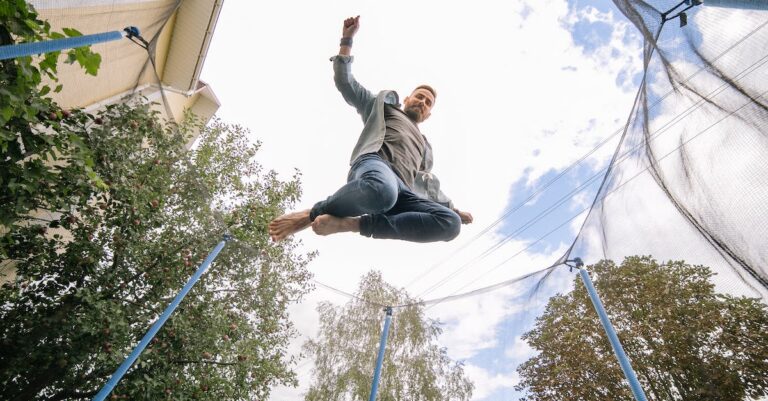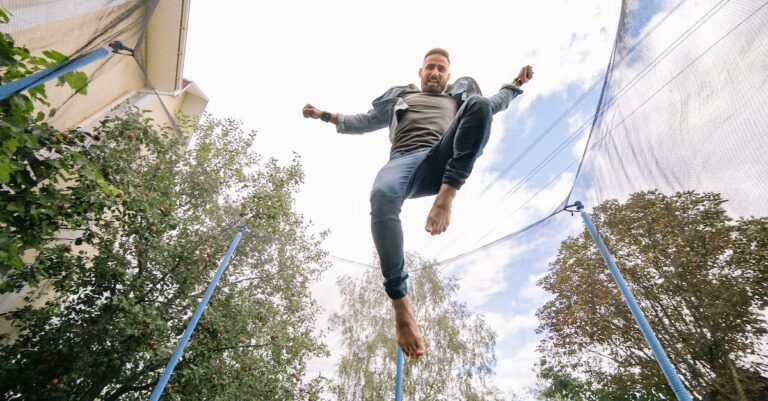Mastering Advanced Trampoline Techniques: Tips from a Pro
Introduction
What are trampolines?
Trampolines are a popular recreational equipment that have gained immense popularity in recent years. They consist of a strong fabric stretched tightly over a steel frame with coiled springs. Trampolines are designed to provide a fun and exhilarating experience, allowing individuals to bounce and perform various acrobatic tricks. They are not only a source of entertainment but also offer numerous health benefits, such as improving cardiovascular fitness, strengthening muscles, and enhancing coordination and balance. Whether you are a beginner or a professional, mastering advanced trampoline techniques can take your skills to the next level. In this article, we will provide valuable tips and insights from a trampoline pro to help you become a master in trampoline techniques.
Benefits of trampolining
Trampolining is not just a fun and exhilarating activity, but it also offers a wide range of benefits. One of the main advantages of trampolining is its ability to improve cardiovascular health. Jumping on a trampoline increases heart rate and oxygen intake, which helps strengthen the heart and improve overall cardiovascular fitness. Additionally, trampolining is a great way to enhance balance and coordination. The constant bouncing and shifting of weight require precise movements, improving motor skills and body control. Moreover, trampolining is a low-impact exercise that puts less stress on joints compared to other high-impact activities. This makes it an ideal choice for individuals with joint issues or those looking for a gentler form of exercise. Lastly, trampolining is a fantastic stress-reliever. The feeling of weightlessness and the release of endorphins during jumping can help reduce anxiety, improve mood, and promote mental well-being. With all these benefits, it’s no wonder trampolining has become a popular choice for fitness enthusiasts and recreational jumpers alike.
Overview of advanced trampoline techniques
In this article, we will provide an overview of advanced trampoline techniques that can take your trampolining skills to the next level. Trampolining is not just about jumping up and down; it is an art that requires precision, control, and creativity. Whether you are a beginner looking to learn new tricks or an experienced trampolinist aiming to master complex maneuvers, this article will provide valuable insights and tips from a professional trampolinist. So, get ready to dive into the world of advanced trampoline techniques and discover the secrets to becoming a trampoline pro!
Choosing the Right Trampoline
Size and shape considerations
When it comes to mastering advanced trampoline techniques, size and shape considerations play a crucial role. The size of the trampoline determines the amount of space available for performing tricks and stunts. A larger trampoline provides more room for jumps and flips, allowing for a greater range of motion and creativity. On the other hand, a smaller trampoline may require more precision and control, as there is less margin for error. Additionally, the shape of the trampoline can also impact the difficulty level of certain tricks. Rectangular trampolines are often preferred for advanced techniques, as they offer a larger jumping area and better bounce. However, circular trampolines can also be used effectively, especially for tricks that involve spinning and rotational movements. Ultimately, understanding and considering the size and shape of the trampoline is essential for mastering advanced trampoline techniques.
Safety features to look for
When it comes to mastering advanced trampoline techniques, safety should always be a top priority. To ensure a safe trampolining experience, it is important to look for certain safety features when purchasing a trampoline. One key feature to consider is a sturdy frame made of durable materials that can withstand the impact of intense jumps and flips. Additionally, a trampoline with a safety enclosure net can provide an extra layer of protection by preventing users from falling off the trampoline. It is also important to check for padding around the edges of the trampoline, which can help cushion any accidental landings. By prioritizing safety features, trampolinists can enjoy pushing their skills to the limit while minimizing the risk of injuries.
Quality and durability
When it comes to trampolines, quality and durability are two essential factors to consider. A high-quality trampoline is built to withstand rigorous use and is made from durable materials that can withstand the elements. Investing in a trampoline that is built to last not only ensures a safe and enjoyable experience, but also saves you money in the long run. Whether you are a professional trampolinist or just a casual jumper, choosing a trampoline with excellent quality and durability is crucial for maximizing your skills and having a great time.
Mastering Basic Trampoline Skills
Proper jumping technique
Proper jumping technique is crucial when it comes to mastering advanced trampoline techniques. It not only ensures your safety but also allows you to perform complex maneuvers with ease and precision. To achieve the perfect jump, start by maintaining a balanced stance with your feet shoulder-width apart. Bend your knees slightly and use your arms to generate momentum as you push off the trampoline surface. As you ascend, focus on keeping your body straight and your core engaged. Remember to land softly by bending your knees upon descent. Practicing and refining your jumping technique will greatly enhance your trampoline skills and take you closer to becoming a pro.
Basic flips and twists
Basic flips and twists are essential skills for any trampoline enthusiast looking to master advanced techniques. These foundational moves lay the groundwork for more complex maneuvers, and they are a great starting point for beginners. Whether it’s executing a front flip or a backflip, or adding a twist to your jumps, mastering these basic flips and twists will not only enhance your trampoline skills but also boost your confidence. With practice and proper technique, you’ll soon be able to perform these moves effortlessly and progress to more challenging trampoline tricks.
Building strength and coordination
Building strength and coordination are essential for mastering advanced trampoline techniques. As a pro in the field, I have learned that these two factors play a crucial role in achieving success and performing complex maneuvers. To build strength, it is important to incorporate exercises that target the core, legs, and upper body. This will not only enhance your overall power but also improve your stability while executing intricate jumps and flips. Additionally, focusing on coordination exercises can help synchronize your movements and improve your timing on the trampoline. By consistently working on building strength and coordination, you will be able to unlock new levels of skill and confidently execute advanced trampoline techniques.
Progressing to Advanced Tricks
Front and back flips
Front and back flips are some of the most exciting and impressive trampoline techniques that advanced jumpers can master. These flips require a combination of strength, agility, and precise timing to execute properly. To perform a front flip, the jumper launches themselves into the air, tucking their knees to their chest, and rotating forward. The key to a successful front flip is to maintain control and balance throughout the entire rotation. On the other hand, back flips involve launching off the trampoline and rotating backward, with the jumper’s body fully extended. It takes practice and skill to generate enough height and momentum for a smooth back flip. Both front and back flips require proper technique, body control, and confidence to execute safely. With dedication and training, jumpers can master these advanced trampoline techniques and add an impressive flair to their repertoire.
Double flips and twists
Double flips and twists are some of the most impressive and challenging trampoline techniques to master. These advanced moves require a combination of strength, agility, and precise timing. Performing a double flip involves rotating your body twice in the air, while a double twist requires twisting your body twice. Both maneuvers demand a high level of skill and control to execute properly. It is essential to have a solid foundation in basic trampoline skills before attempting double flips and twists. Practice, perseverance, and proper technique are key to mastering these advanced trampoline techniques. With dedication and determination, you can become a pro at double flips and twists on the trampoline.
Combining multiple tricks
Combining multiple tricks is an essential skill for mastering advanced trampoline techniques. It allows athletes to create impressive and dynamic routines that captivate audiences. By seamlessly transitioning from one trick to another, athletes can showcase their versatility and creativity. This requires a deep understanding of each trick’s mechanics and timing, as well as the ability to maintain control and balance throughout the routine. With practice and dedication, athletes can elevate their trampoline performances to new heights by effectively combining multiple tricks.
Safety Precautions and Injury Prevention
Using safety nets and pads
When it comes to mastering advanced trampoline techniques, using safety nets and pads is crucial. These safety measures not only protect you from potential falls and injuries but also provide a sense of security and confidence to try out new and challenging moves. Safety nets act as a barrier, preventing you from accidentally bouncing off the trampoline and falling onto the ground. Pads, on the other hand, cushion your landings and reduce the impact on your joints and muscles. By incorporating safety nets and pads into your trampoline routine, you can push your limits and explore the world of advanced trampoline tricks with peace of mind.
Warming up and stretching
Warming up and stretching are essential components of any trampoline training session. Before attempting advanced techniques, it is crucial to prepare the body by increasing blood flow and loosening up the muscles. A proper warm-up routine can help prevent injuries and improve overall performance. Start with light cardio exercises like jogging or jumping jacks to get the heart rate up. Then, move on to dynamic stretches that target the major muscle groups used in trampoline jumping, such as the legs, core, and arms. Incorporating exercises like leg swings, arm circles, and torso twists can help increase flexibility and range of motion. Remember to take your time and listen to your body during the warm-up, gradually increasing the intensity as you go. By dedicating time to warming up and stretching, you can enhance your trampoline skills and enjoy a safer and more effective training experience.
Spotting and supervision
Spotting and supervision are crucial aspects of mastering advanced trampoline techniques. As a pro, I have learned that having a spotter or supervisor can greatly enhance the learning process and ensure safety. A spotter can provide guidance and support, helping to correct form and technique while also preventing accidents and injuries. Additionally, a supervisor can offer valuable feedback and tips for improvement, pushing you to reach new heights in your trampoline skills. Whether you are practicing flips, twists, or complex maneuvers, having someone to spot and supervise can make all the difference in your progress and success.
Tips from a Pro
Training regimen and practice routines
When it comes to mastering advanced trampoline techniques, having a structured training regimen and practice routines is essential. A professional trampolinist understands the importance of consistent and targeted practice to improve their skills and performance. They follow a well-planned training schedule that includes a combination of strength and conditioning exercises, skill drills, and routine rehearsals. By dedicating specific time to different aspects of their trampoline training, they are able to focus on developing and refining their technique, building strength and flexibility, and perfecting their routines. Additionally, they incorporate cross-training activities such as gymnastics, tumbling, and aerial awareness exercises to enhance their overall performance. With a disciplined training regimen and consistent practice routines, aspiring trampolinists can make significant progress and master advanced techniques in no time.
Mental preparation and focus
Mental preparation and focus are crucial when it comes to mastering advanced trampoline techniques. As a pro, I have learned that success on the trampoline is not just about physical strength and skill, but also about having the right mindset. Before attempting any challenging moves, it is important to mentally prepare yourself by visualizing the perfect execution and building confidence. Maintaining focus during practice sessions is equally important, as distractions can lead to mistakes and even injuries. By cultivating a strong mental game, trampoline enthusiasts can enhance their performance and take their skills to the next level.
Common mistakes to avoid
When it comes to mastering advanced trampoline techniques, avoiding common mistakes is crucial. Many beginners make the mistake of not properly warming up before attempting advanced moves, which can lead to injuries. Another common mistake is not maintaining proper form and technique, which can hinder progress and increase the risk of accidents. It is also important to avoid attempting advanced tricks without proper supervision or training, as this can be dangerous. By being aware of these common mistakes and taking the necessary precautions, trampoline enthusiasts can enhance their skills and minimize the risk of injuries.




